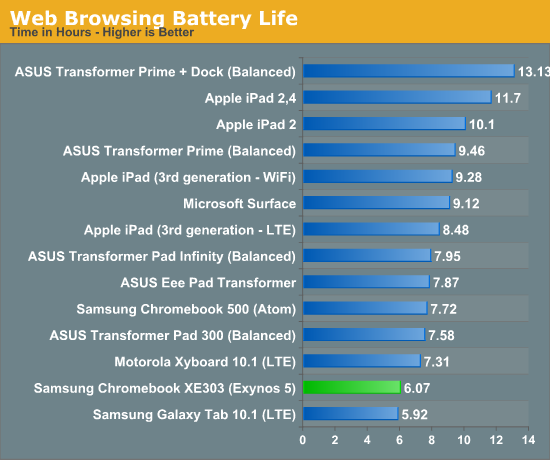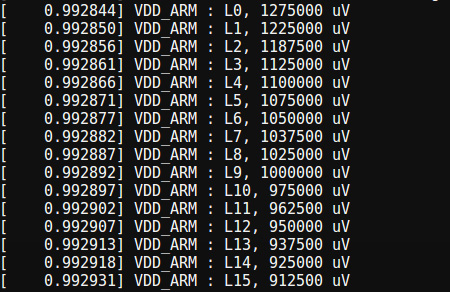Samsung Chromebook (XE303) Review: Testing ARM's Cortex A15
by Anand Lal Shimpi on October 31, 2012 9:00 AM ESTBattery Life & Power Analysis
The final unknown in all of this is power consumption. ARM's Cortex A15 isn't really supposed to be a sipper of power, and when placed in a notebook I don't know that there's a lot we can conclude about how it stacks up to Atom either. Some high level power consumption data would normally help but these two platforms are fairly different:
| Samsung Chromebook Power Consumption Comparison | ||||||
| Display @ 200 nits | Idle | Kraken (Avg) | Kraken (Peak) | |||
| Samsung Chromebook 500 (Atom N570) | 11.53W | 14.4W | 15.2W | |||
| Samsung Chromebook 303 (Exynos 5 Dual) | 6.33W | 10.5W | 11.3W | |||
The new Chromebook consumes considerably less power at idle than its predecessor. The smaller display, simplified motherboard and truly integrated SoC platform are likely all to thank for this. The significant reduction in power also helps explain the big reduction in battery capacity as well.
Under load, the two platforms do see differing levels of additional power consumption. The new Exynos 5 based Chromebook sees a dramatic increase in power consumption under load, hitting 10.5W (a 66% increase over idle) while running Mozilla's Kraken benchmark. The Atom N570 based Chromebook increases power consumption as well, but just not by as significant a degree: ~25%. This actually helps illustrate exactly why Atom wasn't phone worthy in its earlier incarnations. Contrary to popular belief, it wasn't actually peak power consumption that was the problem (a move to 32nm can easily eat into these numbers). The total platform power consumption, particularly at idle, was Atom's real problem in the early days. It also turns out that this is much of what keeps Intel's Core processors from moving into ultra mobile form factors, something that Haswell is supposed to address.
Given that we're dealing with somewhat different panels here, I wanted to see what power consumption looked like if we removed the panels from the equations. I re-ran all of the power data with the display turned off:
| Samsung Chromebook Power Consumption Comparison | ||||||
| Display Off | Idle | Kraken (Avg) | Kraken (Peak) | |||
| Samsung Chromebook 500 (Atom N570) | 8.82W | 11.4W | 12.4W | |||
| Samsung Chromebook 303 (Exynos 5 Dual) | 4.07W | 8.32W | 9.27W | |||
The old Atom based Chromebook uses more than twice the idle power of the new version - it's no wonder Google was able to get away with a battery half the size. Once again however we see a much larger increase in power consumption once the Cortex A15 is under heavy load. Active power consumption more than doubles on the new Chromebook, while we see around a 30% increase on the Atom based system. I do wonder what will have to be done to get the Exynos 5 Dual into a smartphone as an increase of ~4W under load just won't cut it in a phone. The Atom platform shows a 2.6W increase in power under load, which sounds about right for a high clocked 45nm part.

Despite the more power efficient platform, the reduction in battery capacity puts the new Chromebook well below the Atom model in battery life. Our wireless web browsing test put the new Chromebook at just over 6 hours of continuous use on a single charge. For a notebook that's not too bad, but compared to modern tablets it's not good.

The performance gains over Atom (and by extension, the ARM Cortex A9) do give us some indication as to what could be done to get Exynos 5 into a smartphone. By dropping clocks much lower than 1.7GHz Samsung would be able to maintain a performance advantage in a very power constrained device and hopefully keep power in check. The photo above features a list of all of the voltage levels supported by Samsung's Exynos 5 Dual as implemented in the new Chromebook.










149 Comments
View All Comments
rootheday - Wednesday, October 31, 2012 - link
sure, the Atom N570 on 45nm is not so competitive on power and performance but I think it is misleading to compare A15 vs this rev of Atom because newer and better Intel processors are available....I think more interesting comparison point for future competitors to A15 would be:
Acer Aspire One 756 - 11.6" notebook with Sandybridge Pentium or Celeron - I have seen it as low as $290 at Best Buy and Costco. Similar price point but way more performant.
Clovertrail based machines - reviewed on this site.. http://www.anandtech.com/show/6340/intel-details-a...
... while this is Win8 not ChromeOS, I would expect power and performance to be similar.
Krysto - Thursday, November 1, 2012 - link
I bet those don''t look as good as the Chromebook either. You're paying for the whole package.Midwayman - Wednesday, October 31, 2012 - link
I just wish the Surface had shipped with this SOC. Windows RT sounds more interesting than chrome, but it got saddled with a much older SOC in a product twice the cost.andrewaggb - Wednesday, October 31, 2012 - link
me too. If surface had this SOC with a higher res screen, I'd buy one. Instead I'm waiting for a hardware refresh. Tegra3 and atom are too slow, i5 is too power hungry.amdwilliam1985 - Wednesday, October 31, 2012 - link
I agree, Tegra 3 and current Atom are too slow, but the upcoming Atom should be better. I'm considering buying that instead of windows RT as a media pc replacement.I'm hearing a lot of miracast, has anyone coming out with the dongle yet? anything decent in the retail?
jeffkro - Wednesday, October 31, 2012 - link
Haswell should make a pretty nice media PC. Its suppose to be really good with power consumption especially if you get into the ULV versions. If your media PC is plugged into the wall the difference between 10W or 20-30W isn't that big of a deal. I'm pretty big into HTPC and I'm probably going to swap out my llano system for haswell when the i3 or pentium versions are released.amdwilliam1985 - Wednesday, October 31, 2012 - link
Sorry, I probably mislead you.What I'm looking for is surface type of tablet when I want to work on a tablet, and then I can dock it on my coffee table and use miracast as a wireless mirror display. That way, I can get rid of laptop, tablet and media pc and use 1 device only.
Currently I have an old core 2 duo laptop plug in 24/7 with a hdmi display and a wireless mouse as a media pc. The laptop is getting old and a replacement is needed soon.
wsw1982 - Thursday, November 1, 2012 - link
the samsung a15 is also 6+ w range soc according to the reviewKrysto - Thursday, November 1, 2012 - link
Anand has said Haswell will have higher TDP than IVB on the same level of performance. That 10W variant is just a significantly lower powered version.tipoo - Wednesday, October 31, 2012 - link
Agreed, even WP8 got a better SoC than T3 (Krait). Odd choice. Snapdragon S4 Pro in the surface would have been nice.